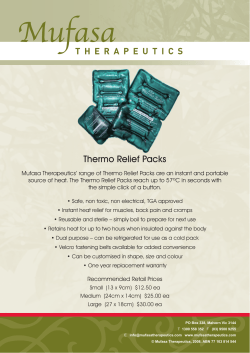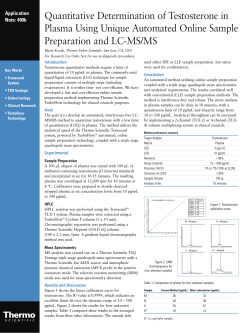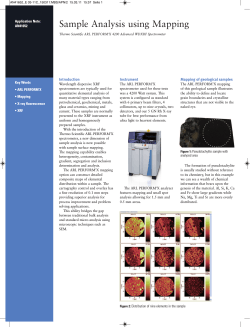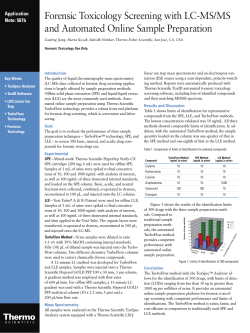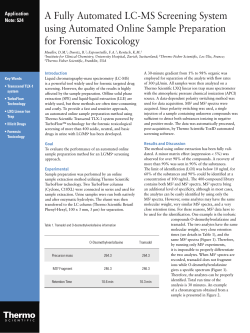
Exploring the Benefits of Automated Unattended Sample Derivatization Prior
Exploring the Benefits of Automated Unattended Sample Derivatization Prior to Gas Chromatography Analysis A. Caruso, M. Santoro, P. Magni, S. Pelagatti, and R. Facchetti Thermo Fisher Scientific, Milan, Italy Overview Purpose: Exploring the possibility to perform the sample preparation steps necessary for the derivatization of analytes in a fully automated and reliable way with the use of the same robotic sampler used for sample injection into the gas chromatograph. Methods: As an example of application, we screened dairy products for melamine and its derivates presence via GC-MS/MS. Results: The outcomes are positive, and precise results show it is possible to reliably automate sample preparation operations with full automatization of GC-MS analysis. Introduction Sample derivatization is often used in GC and GC/MS analyses to enhance the volatility of certain compounds. Strong intermolecular attractions between polar groups such as NH, SH or OH, groups can create hydrogen bonds that lead to molecular attraction and reduce volatility. Replacing hydrogen in these groups by alkylation, acylation, or silylation significantly increases volatility, especially in compounds with multiple polar groups. Typically, the replacement of active hydrogens with trimethylsilyl groups leads to volatile derivatives that can readily undergo GC analysis. The derivatization prep volumes for samples, s mL and 10 mL , choosin and can work with vial v possibility to scale dow money and reducing th Automation of Sample Food Safety Studies The cycle has been use and the injections for th acid, ammeline, and am The sample preparation in parallel, to validate th Melamine is an industri manufacture of plastics ammeline, and ammelid ingestion of melamine ( With GC-MS/MS, it is p the four compounds wit The extracted samples analysis. A typical silylation reaction requires the addition of a reagent such as MSTFA, TMCS, or BSTFA in presence of a base in an anhydrous and heated environment and may last several minutes. The length of the reaction, and the fact that often these additions of liquid reagents must be carried out manually are downsides of the process and negatively affect overall laboratory throughput. FIGURE 3. Structure o ammelide, and ammel The introduction of a system capable of handling much of the sample preparation process automatically can increase laboratory throughput and free the operator from the most tedious, time-consuming and error-prone steps. The Thermo Scientific™ TriPlus™ RSH autosampler is an example of such a system. Methods The TriPlus RSH autosampler is a versatile automatic sampling platform that is also capable of advanced sample preparation cycles, enabling excellent precision and reproducibility and ensuring unattended and reliable operations. 2 The derivatization prep unattendedly and reliab derivatizating agents an incubating samples into according to the protoc time. At the end of a de automatically injected b GC/MS. FIGURE 1. TriPlus RSH autosampler, Thermo Scientific™ 1310Derivatization GC andPrior TSQ™ mass spectrometer Exploring the Benefits of AutomatedTRACE™ Unattended Sample to Gas 800 Chromatography Analysis The sample preparation with the TriPlus RSH au 1310 Gas Chromatogra quadrupole mass spect and processed with The system. Sample Preparation Common retail milk pro standard solutions of th standard, prepared at v and reproducibility and ensuring unattended and reliable operations. FIGURE 1. TriPlus RSH autosampler, Thermo Scientific™ TRACE™ 1310 GC and TSQ™ 800 mass spectrometer Preparation Cycles The TriPlus RSH has the capability to perform sample preparation by using prep cycles. Prep cycles are precompiled, software-driven sets of operations for the TriPlus RSH autosampler that allow users to go beyond standard injection functions. Using prep cycles, the instrument can perform sample preparation procedures, such as calibration curve building, dilutions or derivatizations in an unattended, reliable and fully automated fashion. The TriPlus RSH autosampler can automate these cycles with the innovative Automatic Tool Changing Station (ATC), which can hold multiple syringes and automatically change them, as an example for switching from liquid to headspace to SPME analyses in the same sequence or simply to handle different liquid volumes with the utmost precision (See Figure 2.) Sample Preparation Common retail milk prod standard solutions of the standard, prepared at va derivatization has been e TriPlus RSH autosample The sample extraction pr methods for the screenin ammeline, and cyanuric The TriPlus RSH autosam solution of acetonitrile an extract and then the vial 200 µL BSTFA with 1 % vortexed for 1 min and th The previous operation, injection, is performed in autosampler. The user m configuration and syringe onto the tray, and load th and run it for the number The entire sample prepa of the sample sequence; sequence occurs. FIGURE 4. Xcalibur CDS FIGURE 5. Automated D interface. FIGURE 2. TriPlus RSH ATC station. Thermo Scientific Poster Note • PN10388_ISCC_2014_E_05/14S 3 bility to perform the sample or the derivatization of nd reliable way with the use sed for sample injection into pplication, we screened nd its derivates presence via ositive, and precise results utomate sample preparation tion of GC-MS analysis. used in GC and GC/MS lity of certain compounds. ns between polar groups s can create hydrogen ttraction and reduce n these groups by on significantly increases nds with multiple polar ment of active hydrogens to volatile derivatives that sis. uires the addition of a S, or BSTFA in presence of eated environment and may h of the reaction, and the of liquid reagents must be sides of the process and tory throughput. apable of handling much of s automatically can and free the operator from ing and error-prone steps. s™ RSH autosampler is an is a versatile automatic capable of advanced abling excellent precision ng unattended and reliable The derivatization prep cycle can handle the entire process unattendedly and reliably. It offers the possibility of adding derivatizating agents and internal standards, vortexing and incubating samples into an oven or into cooled trays, according to the protocol followed, for a user-selectable time. At the end of a derivatization batch, samples can be automatically injected by the same sampler into a GC or a GC/MS. The derivatization prep cycle is able to handle liquid volumes for samples, standards, and reagents between 1 mL and 10 mL , choosing the proper syringes accordingly, and can work with vial volumes from 2–100 mL, offering the possibility to scale down the volumes used, thus saving money and reducing the chemical waste generated. Automation of Sample Derivatization Procedures in Food Safety Studies The cycle has been used to perform the derivatization step and the injections for the analysis of melamine, cyanuric acid, ammeline, and ammelide by GC-MS in milk products. The sample preparation procedure is carried out manually, in parallel, to validate the results obtained. Melamine is an industrial chemical, commonly used in the manufacture of plastics and colorants; cyanuric acid, ammeline, and ammelide are the metabolites found after ingestion of melamine (Figure 3). Gas Chromatograp • Oven: starting 300 at 15 °C/min • Injector: 250 °C mode for 120 se Column: Thermo Sc x 0,25 µm Mass Spectrometr The TSQ 8000 mas with retention times optimized for each a and ion source were Results None of the analyze positive for the prese compounds. A milk sample was s concentration of 12 Standard solutions o concentrations of 2.5 excellent results in t FIGURE 6. Lineariti shown as examples With GC-MS/MS, it is possible to determine the content of the four compounds with excellent sensitivity and specificity. The extracted samples must be derivatizated before the analysis. FIGURE 3. Structure of melamine, cyanuric acid, ammelide, and ammeline. The results for the m and the standard so procedures done ma using the TriPlus RS Methods The sample preparation and analysis has been performed with the TriPlus RSH autosampler coupled with a TRACE 1310 Gas Chromatograph and a TSQ 8000 triple quadrupole mass spectrometer. The data were collected and processed with Thermo Scientific™ Xcalibur data system. Sample Preparation Common retail milk products were analyzed in parallel with ampler, Thermo Scientific™ standard solutions of the four analytes, plus the internal ™ 800 mass spectrometer Sample Derivatization to Gas Chromatography Analysis Sample 4 Exploring the Benefits of Automated Unattended standard, preparedPrior at various concentrations. derivatization has been executed manually and via the FIGURE 7. SRM res Melamine, 2 .) Cyan excellent precision tended and reliable r, Thermo Scientific™ mass spectrometer perform sample p cycles are preations for the sers to go beyond p cycles, the ation procedures, tions or ble and fully omate these cycles anging Station s and automatically hing from liquid to ame sequence or es with the utmost and processed with Thermo Scientific™ Xcalibur data system. Sample Preparation Common retail milk products were analyzed in parallel with standard solutions of the four analytes, plus the internal standard, prepared at various concentrations. Sample derivatization has been executed manually and via the TriPlus RSH autosampler to compare the results obtained. The sample extraction protocol used follows the US FDA methods for the screening of melamine, ammelide, ammeline, and cyanuric acid (version 2.1) [1] Conclusion The TriPlus RSH autosam system that is also capabl cycles, enabling excellent ensuring unattended and r The TriPlus RSH autosampler is used to add 300 µL of a solution of acetonitrile and pyridine (1:1) to the sample extract and then the vial is vortexed for 30 seconds. Next, 200 µL BSTFA with 1 % TMS is added to the vial and is vortexed for 1 min and then incubated at 70 °C for 45 min. The previous operation, like the subsequent GC/MS injection, is performed in an unattended fashion by the autosampler. The user must have the requested hardware configuration and syringes, load the samples and reagents onto the tray, and load the prep cycle into a CDS sequence and run it for the number of samples to be analyzed. The entire sample preparation procedure uses the first line of the sample sequence; after that, the usual injection sequence occurs. The powerful platform com autosampler, a TRACE 13 a sensitive and reliable an and analyzing a high numb improving laboratory throu performances. An example has been sho procedure for the determin and related by-products in linearity and recoveries. FIGURE 4. Xcalibur CDS samples calibration sequence. Similar automated cycles c derivatization procedures to GC and GC/MS analysi chance for errors, minimiz amounts of chemicals use decreasing the cost of che FIGURE 5. Automated Derivatization Prep cycle user interface. nded Sample Derivatization Prior to References 1. FDA GC-MS Screen for Ammeline, Ammelide and . ndle the entire process e possibility of adding ndards, vortexing and to cooled trays, r a user-selectable tch, samples can be ampler into a GC or a o handle liquid All trademarks are the property of Thermo Fisher S This information is not intended to encourage use o property rights of others. Gas Chromatography • Oven: starting temperature 75 °C for 1 minute, raise to 300 at 15 °C/min, hold for 10 minutes • Injector: 250 °C, carrier gas Helium 1 mL/min, splitless mode for 120 seconds Column: Thermo Scientific™ TRACE TR5-MS 30 m x 0,25 cm x 0,25 µm Thermo Scientific Poster Note Mass Spectrometry The TSQ 8000 mass spectrometer was operated in SRM mode • PN10388_ISCC_2014_E_05/14S 5 batch, samples can be sampler into a GC or a e to handle liquid nd reagents between 1 er syringes accordingly, m 2–100 mL, offering the es used, thus saving waste generated. ation Procedures in m the derivatization step of melamine, cyanuric GC-MS in milk products. is carried out manually, btained. , commonly used in the nts; cyanuric acid, metabolites found after Column: Thermo Scientific™ TRACE TR5-MS 30 m x 0,25 cm x 0,25 µm Mass Spectrometry The TSQ 8000 mass spectrometer was operated in SRM mode with retention times, collision energies, and precursor ions optimized for each analyte. The temperature of transfer line and ion source were, respectively 250 °C and 270 °C. Results None of the analyzed commercially available milk samples were positive for the presence of melamine or the other target compounds. A milk sample was spiked with the target analytes at a concentration of 12 ppb each and tested via GC-MS/MS. Standard solutions of the four analytes were analyzed at concentrations of 2.5, 5, 10, 50, and 100 ppb each, and showed excellent results in terms of linearity. FIGURE 6. Linearities for melamine and cyanuric acid shown as examples. etermine the content of sensitivity and specificity. rivatizated before the e, cyanuric acid, The results for the milk samples, the standard spiked samples, and the standard solutions obtained with the derivatization procedures done manually were in line with those obtained using the TriPlus RSH autosampler prep cycle. FIGURE 7. SRM results for the compounds screened. 1.) Melamine, 2 .) Cyanuric Acid, 3.) Ammeline, 4.) Ammelide. sis has been performed coupled with a TRACE SQ 8000 triple he data were collected ific™ Xcalibur data analyzed in parallel with ytes, plus the internal centrations. Sample manually and via the are the results obtained. ed follows the US FDA mine, ammelide, on 2.1) [1] Conclusion The TriPlus RSH autosampler is a versatile automatic sampling system that is also capable of advanced sample preparation sed to add 300 µL of a 6 Exploring the Benefits of Automated Unattended Sample Derivatization Prior to Gas Chromatography Analysis cycles, enabling excellent precision and reproducibility and (1:1) to the sample ly and via the results obtained. ws the US FDA ammelide, ) [1] add 300 µL of a o the sample 0 seconds. Next, the vial and is 70 °C for 45 min. ent GC/MS ashion by the uested hardware ples and reagents o a CDS sequence e analyzed. uses the first line sual injection ation sequence. ep cycle user Conclusion The TriPlus RSH autosampler is a versatile automatic sampling system that is also capable of advanced sample preparation cycles, enabling excellent precision and reproducibility and ensuring unattended and reliable operations. The powerful platform comprised of the TriPlus RSH autosampler, a TRACE 1300 Series GC, and TSQ 8000 MS, is a sensitive and reliable analytical system capable of derivatizing and analyzing a high number of samples unattendedly, improving laboratory throughput with excellent analytical performances. An example has been shown of the automated derivatization procedure for the determination of contaminants like melamine and related by-products in milk, which provided outstanding linearity and recoveries. Similar automated cycles could be used to accelerate the derivatization procedures for biological and food samples prior to GC and GC/MS analysis, reducing operator time and the chance for errors, minimizing carryover, and reducing the amounts of chemicals used and waste generated, thus decreasing the cost of chemical waste handling. References 1. FDA GC-MS Screen for the Presence of Melamine, Ammeline, Ammelide and Cyanuric Acid. All trademarks are the property of Thermo Fisher Scientific and its subsidiaries. This information is not intended to encourage use of these products in any manners that might infringe the intellectual property rights of others. www.thermoscientific.com ©2014 Thermo Fisher Scientific Inc. All rights reserved. ISO is a trademark of the International Standards Organization. All other trademarks are the property of Thermo Fisher Scientific Inc. and its subsidiaries. This information is presented as an example of the capabilities of Thermo Fisher Scientific products. It is not intended to encourage use of these products in any manners that might infringe the intellectual property rights of others. Specifications, terms and pricing are subject to change. Not all products are available in all countries. Please consult your local sales representative for details. Africa +43 1 333 50 34 0 Australia +61 3 9757 4300 Austria +43 810 282 206 Belgium +32 53 73 42 41 Canada +1 800 530 8447 China 800 810 5118 (free call domestic) 400 650 5118 Denmark +45 70 23 62 60 Europe-Other +43 1 333 50 34 0 Finland +358 9 3291 0200 France +33 1 60 92 48 00 Germany +49 6103 408 1014 India +91 22 6742 9494 Italy +39 02 950 591 Japan +81 45 453 9100 Latin America +1 561 688 8700 Middle East +43 1 333 50 34 0 Netherlands +31 76 579 55 55 New Zealand +64 9 980 6700 Norway +46 8 556 468 00 Russia/CIS +43 1 333 50 34 0 Thermo Fisher Scientific, Austin, TX USA is ISO 9001:2008 Certified. Singapore +65 6289 1190 Spain +34 914 845 965 Sweden +46 8 556 468 00 Switzerland +41 61 716 77 00 UK +44 1442 233555 USA +1 800 532 4752 PN10388_E 05/14S
© Copyright 2025


